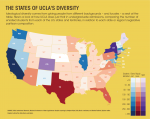To Californians, UCLA is a reputed public university with a lot of school spirit. Ask someone in the Midwest, though, and they might just think it’s a stronghold of abortion rights-, gun control-advocating college liberals.
You wonder why UCLA has no enrolled students from Wyoming.
UCLA talks a lot about diversity among its student body. But lost in this conversation is the glaring lack of geographic diversity among Bruins.
UCLA is a public California university, and understandably prioritizes the enrollment of in-state students. University of California policy caps out-of-state enrollment at 18% of the entire student body. But who makes up this 18% is massively skewed.
According to UCLA Institutional Research, 24,150 Californian undergraduates are currently enrolled at UCLA. From the roughly 7,000 remaining students, there are large parts of the country that have little representation at all.
UCLA has 10 or fewer students from many states in the Deep South, including Alabama, Arkansas and Mississippi. The Midwest is similarly underrepresented. Less than 10 students come from each Nebraska, North Dakota and South Dakota, and 12 come from Idaho. No Bruins call the Equality State their home.
But cultivating geographic diversity at UCLA is crucial to strengthening diversity of thought. Having students from different backgrounds increases diversity, as students are more likely to encounter a viewpoint or experience different than their own. Such diversity of thought is important as it prevents echo chambers, where students only hear perspectives that strengthen their existing views and miss out on opportunities to learn from their peers’ ideologies.
UCLA should increase admissions outreach efforts in underrepresented regions of the country, such as the Midwest and South. Doing so would strengthen diversity of thought at UCLA and offer students a more intellectually stimulating environment – something vital to any university.
UCLA clearly does well in its outreach toward underrepresented communities in California. The Los Angeles Times reported in 2016 that UCLA had expanded intensive recruiting to reach marginalized students. UCLA admissions recruiters show up at community events and college fairs in these communities to scout promising students.
But the university doesn’t do this for out-of-state students, despite its lack of geographic diversity.
“UCLA does outreach only in California, and our recruitment efforts are mostly focused on in-state students,” said UCLA spokesperson Ricardo Vazquez.
A lack of regional diversity hurts ideological diversity, as students are less likely to meet those outside their own background and circumstances. Such shrinking of perspectives contributes to the primarily left-leaning bastion that is UCLA, which doesn’t challenge students to question their viewpoints.
Gary Orfield, a professor of education, law, political science and urban planning, said universities that value leadership and ideological diversity among their students help themselves by expanding geographic diversity.
“If UCLA has the aspiration to train more national leaders, then geographic diversity is very important,” Orfield said. “African Americans from the South have different experiences from those who grew up in Oakland, as Latinos from the East Coast have different experiences from those growing up in Southern California.”
Orfield is right. Such diversity better prepares students for the real world where they won’t always be in proximity to those with similar backgrounds.
These ideas about intellectual diversity are supported by UCLA’s own statement on diversity, which emphasizes the importance of working to increase the “spectrum of perspectives available on campus.”
Brayden Sutton, a first-year biochemistry student from North Carolina, said he thinks it’s important that UCLA emphasize diversity of background. He said he’s from a rural, conservative community with strong views on issues such as gun control.
The California bubble at UCLA, however, limits the contribution of people with these perspectives, impeding the inclusivity the campus administration likes to tout.
Catherine LaRue, a third-year economics student from Topeka, Kansas, said she was surprised by her peers’ lack of knowledge about areas outside California.
“People assume I live on a farm,” LaRue said. “A big part of college is seeing what’s outside of what you’re used to and people from other backgrounds can contribute there.”
Similarly, Mariah McCashland, a third-year neuroscience student from Nebraska, said that her community in Lincoln is relatively conservative on issues such as gun laws and feminism.
“There’s a huge difference of background that you get at UCLA compared to Lincoln,” she said. “Certain things (are) more popular to take a side on here – it’s definitely more popular to be a social liberal.”
Many communities in other states rarely see any signs of UCLA activity, and sending recruiters to those regions would raise the school’s profile among students who might otherwise not know to apply.
It’s true UCLA has a priority to serve Californians first, and not all out-of-state students are interested in applying to the university. But this shouldn’t mean kicking geographic diversity to the curb and foregoing the chance to raise UCLA’s profile among underrepresented regions.
The university is a better institution when its out-of-state enrollment reflects the unique and disparate regions that make up America. After all, the real world is full of both churchgoing, gun-loving Midwesterners and hip, abortion-rights Angelenos who drink Yerba Mate.
